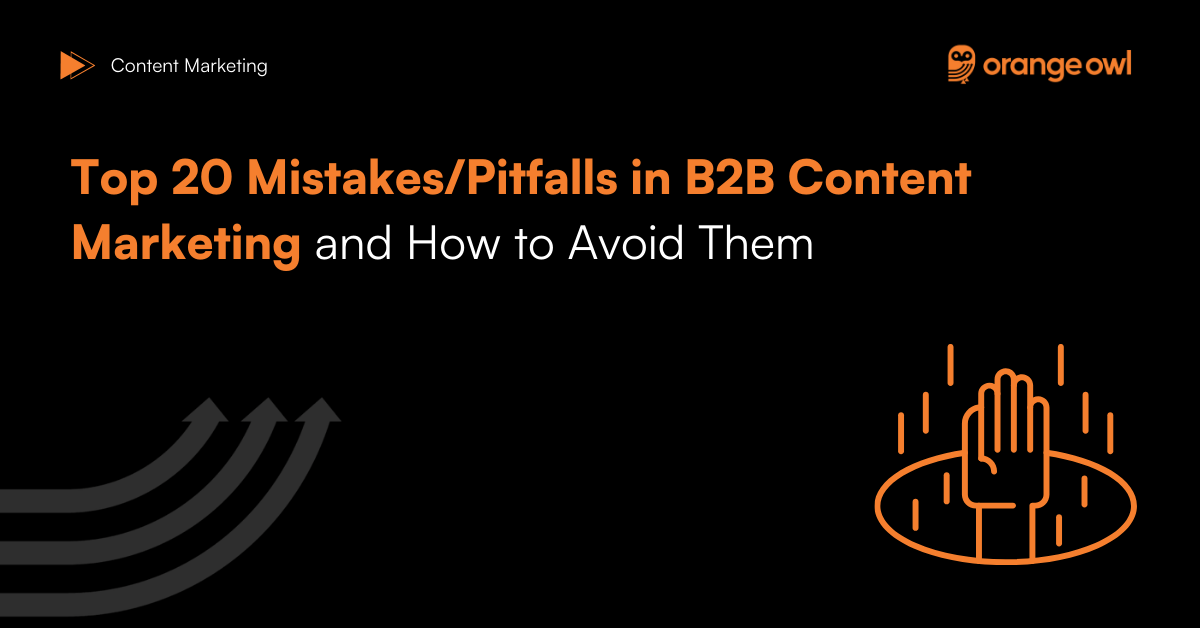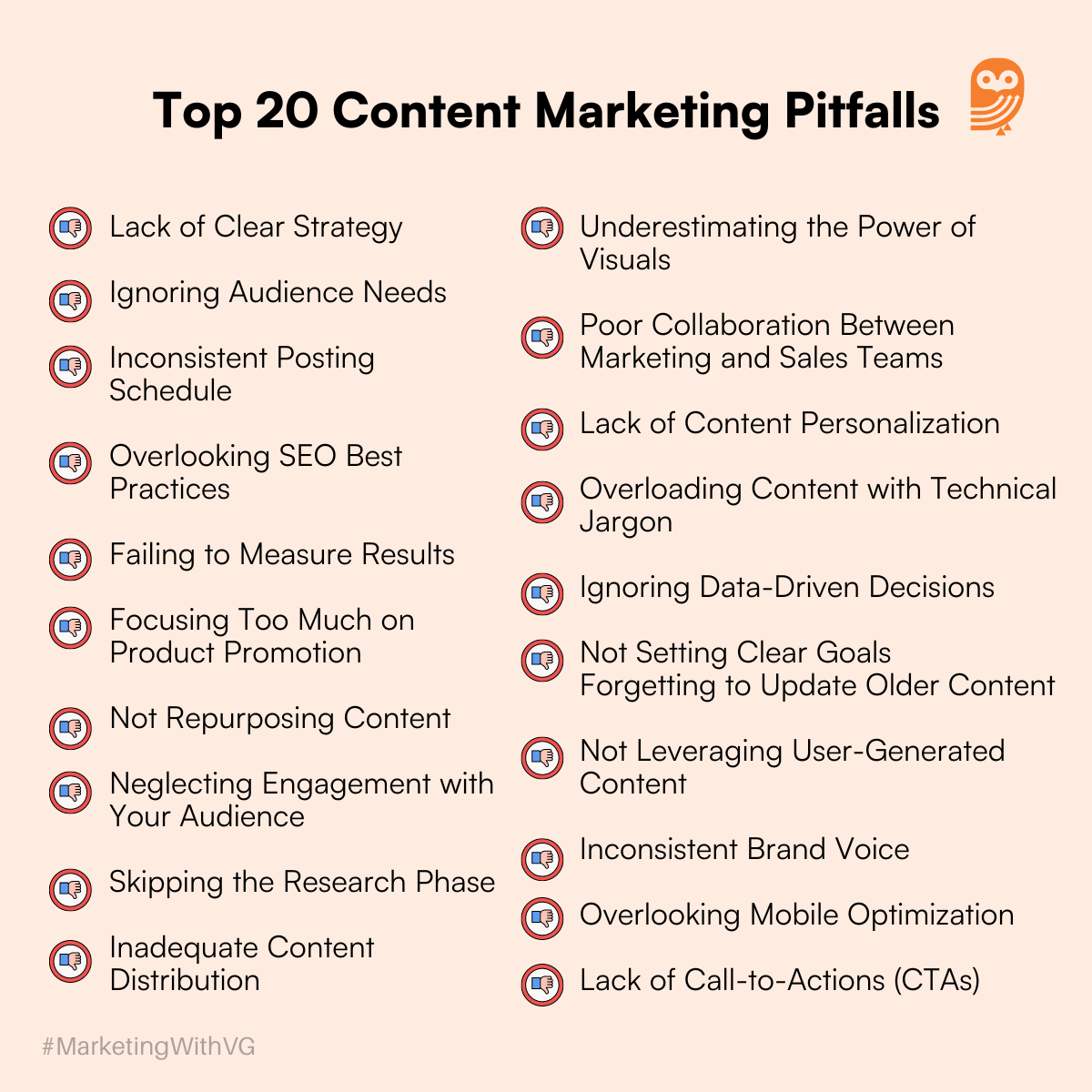Top 20 B2B Content Marketing Mistakes and How to Avoid Them
Vivek Goel
February 4, 2025

Table of Contents
Navigating the world of B2B content marketing can be challenging. However, being aware of common mistakes (pitfalls) and knowing how to avoid them can significantly enhance your strategy’s effectiveness. Here are the top 20 mistakes B2B companies make in content marketing, along with practical solutions and real-world examples.
Top 20 B2B Content Marketing Mistakes

Mistake 1: Lack of Clear Strategy
Pitfall: Without a clear content marketing strategy, efforts can become disjointed and ineffective.
Example: A B2B SaaS company randomly publishes blog posts without a cohesive plan.
Solution: Develop a comprehensive content plan that aligns with your business goals and target audience needs. Regularly review and adjust your strategy to stay on track. Utilize tools like HubSpot’s Marketing Hub for planning and analytics.
Mistake 2: Ignoring Audience Needs
Pitfall: Creating content that doesn’t resonate with your audience can result in low engagement.
Example: A cybersecurity firm producing generic content that doesn’t address specific industry pain points.
Solution: Conduct thorough audience research to understand their pain points and interests. Use surveys, interviews, and tools like Google Analytics to gather insights and craft content that addresses these areas.
Mistake 3: Inconsistent Posting Schedule
Pitfall: Inconsistent content posting can lead to decreased visibility and audience trust.
Example: A manufacturing company that sporadically updates its blog.
Solution: Establish a consistent posting schedule and stick to it. Use content calendars and scheduling tools like Buffer or Hootsuite to plan and maintain regular output.
Mistake 4: Overlooking SEO Best Practices
Pitfall: Neglecting SEO can limit your content’s reach and impact.
Example: An enterprise solutions provider is not optimizing its blog posts for relevant keywords.
Solution: Integrate SEO best practices into your content creation process. Focus on keyword research, meta descriptions, and optimizing for search engines using tools like SEMrush or Ahrefs.
Mistake 5: Failing to Measure Results
Pitfall: Without measuring results, it’s hard to know what’s working and what’s not.
Example: A financial services firm is not tracking the performance of its content marketing campaigns.
Solution: Implement analytics tools like Google Analytics or HubSpot to track your content’s performance. Use the insights to refine your strategy and enhance your content marketing efforts.
Mistake 6: Focusing Too Much on Product Promotion
Pitfall: Excessive self-promotion can turn your audience away.
Example: A CRM software company only publishes product-centric content.
Solution: Balance your content with valuable insights, industry news, and helpful tips. Aim to educate and inform your audience, not just sell to them.
Mistake 7: Not Repurposing Content
Pitfall: Creating content from scratch every time can be time-consuming and inefficient.
Example: A B2B tech company not leveraging existing webinars for blog posts or infographics.
Solution: Repurpose existing content into different formats, such as blog posts, infographics, videos, and social media posts. This maximizes your content’s reach and utility.
Mistake 8: Neglecting Engagement with Your Audience
Pitfall: Failing to engage with your audience can result in missed opportunities for relationship building.
Example: A logistics company is not responding to comments on its LinkedIn posts.
Solution: Actively respond to comments, messages, and feedback. Foster a community around your content by encouraging discussions and interaction.
Mistake 9: Skipping the Research Phase
Pitfall: Skipping thorough research can lead to content that misses the mark.
Example: An IT consulting firm creating content based on assumptions rather than data.
Solution: Invest time in researching industry trends, audience preferences, and competitor content. Use this data to create informed and relevant content that resonates with your target audience.
Mistake 10: Inadequate Content Distribution
Pitfall: Even the best content won’t perform if it’s not properly distributed.
Example: A SaaS company relying solely on its blog to distribute content.
Solution: Develop a robust distribution strategy that includes social media, email marketing, and partnerships with industry influencers to amplify your content’s reach.
Mistake 11: Underestimating the Power of Visuals
Pitfall: Ignoring visual content can make your content less engaging.
Example: A financial advisory firm only uses text in their reports and blog posts.
Solution: Incorporate visuals such as images, infographics, and videos to enhance your content and capture your audience’s attention. Visual content is more likely to be shared and remembered.
Mistake 12: Poor Collaboration Between Marketing and Sales Teams
Pitfall: Misalignment between marketing and sales can lead to ineffective content.
Example: A B2B software company where marketing and sales do not share insights or align on content goals.
Solution: Foster strong collaboration between marketing and sales teams. Regularly share insights and feedback to ensure content meets the needs of both teams and drives results.
Mistake 13: Lack of Content Personalization
Pitfall: Generic content can fail to resonate with individual audience segments.
Example: A cloud services provider sends the same email newsletter to all its subscribers.
Solution: Use data and insights to personalize your content. Tailor your messages to address the specific needs and preferences of different segments of your audience.
Mistake 14: Overloading Content with Technical Jargon
Pitfall: Using too much technical language can alienate your audience.
Example: A biotech company producing content filled with complex terms that are difficult for non-experts to understand.
Solution: Keep your content clear and accessible. Use simple language and explain technical terms when necessary to ensure your audience understands your message.
Mistake 15: Ignoring Data-Driven Decisions
Pitfall: Making content decisions without data can lead to ineffective strategies.
Example: A digital marketing agency creating content based on intuition rather than analytics.
Solution: Use analytics and performance data to guide your content strategy. Regularly review metrics to understand what’s working and what’s not, and adjust accordingly.
Mistake 16: Not Setting Clear Goals
Pitfall: Lack of clear goals can result in aimless content creation.
Example: A cybersecurity firm producing content without specific objectives in mind.
Solution: Define specific, measurable, achievable, relevant, and time-bound (SMART) goals for your content marketing efforts. This provides direction and helps measure success.
Mistake 17: Forgetting to Update Older Content
Pitfall: Neglecting to update outdated content can harm your credibility.
Example: A B2B legal services firm with outdated blog posts on changing regulations.
Solution: Regularly review and refresh older content to ensure it remains relevant and accurate. This can also boost your SEO and provide ongoing value to your audience.
Mistake 18: Not Leveraging User-Generated Content
Pitfall: Overlooking user-generated content can result in missed engagement opportunities.
Example: An enterprise software company not featuring customer reviews or testimonials.
Solution: Encourage your customers to share their experiences and feature their content on your platforms. User-generated content builds trust and authenticity.
Mistake 19: Inconsistent Brand Voice
Pitfall: Inconsistent brand voice can confuse your audience and dilute your message.
Example: A professional services firm with varying tones across different content pieces.
Solution: Develop a clear brand voice and ensure all content aligns with it. This creates a cohesive and recognizable brand identity.
Mistake 20: Overlooking Mobile Optimization
Pitfall: Neglecting mobile optimization can limit your content’s reach.
Example: A B2B e-commerce platform not optimizing its content for mobile devices.
Solution: Ensure your content is mobile-friendly. Optimize your website, emails, and other digital assets for mobile viewing to reach a broader audience.
Mistake 21: Lack of Call-to-Actions (CTAs)
Pitfall: Not including CTAs can lead to missed conversion opportunities.
Example: A B2B accounting firm publishing blog posts without encouraging readers to take the next step.
Solution: Incorporate clear and compelling CTAs in your content. Guide your audience on the next steps, whether it’s downloading a resource, signing up for a webinar, or contacting your sales team.
Conclusion
Navigating the pitfalls of B2B content marketing requires awareness, strategic planning, and continuous improvement. By understanding and addressing these common mistakes, you can create a more effective and impactful content marketing strategy. Remember, the key to success lies in delivering valuable, relevant, and engaging content that meets the needs of your audience while aligning with your business goals. Implement these solutions and watch your B2B content marketing efforts drive significant growth and success.
Top Frequently Asked Questions (FAQs) about B2B Content Marketing Mistakes
Common signs include low engagement rates, high bounce rates, declining website traffic, minimal lead generation, and poor SEO rankings. If your content isn’t resonating with your audience, it may indicate that your strategy needs to be re-evaluated. Regularly analyze performance metrics and seek feedback from your audience to identify areas for improvement.
To make your content stand out, focus on creating high-quality, valuable content that addresses specific pain points and challenges of your target audience. Use unique insights, data, and case studies to differentiate your content. Additionally, employing a strong brand voice and engaging visuals can help capture attention and drive engagement.
Audience segmentation allows you to tailor your content to meet the unique needs and preferences of different customer groups. This increases the relevance and impact of your content. To segment your audience effectively, use data such as industry, company size, job roles, and past interactions with your content. Tools like CRM systems and marketing automation platforms can help in creating detailed audience segments.
Thought leadership helps establish your company as an authority in your industry, building trust and credibility with your audience. It involves sharing expert insights, industry trends, and innovative solutions. Incorporate thought leadership content such as whitepapers, webinars, and opinion articles into your strategy to demonstrate your expertise and attract a loyal following.
To measure effectiveness, track key performance indicators (KPIs) such as website traffic, engagement metrics (likes, shares, comments), lead generation, conversion rates, and SEO rankings. Use analytics tools like Google Analytics, HubSpot, or SEMrush to gather data and gain insights. Regularly review these metrics to understand what’s working and where adjustments are needed.

